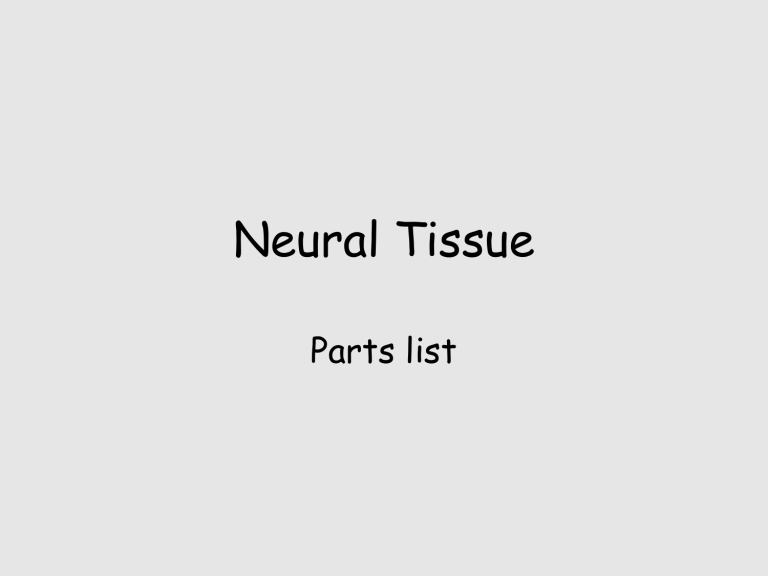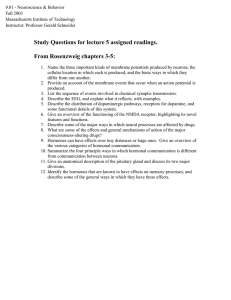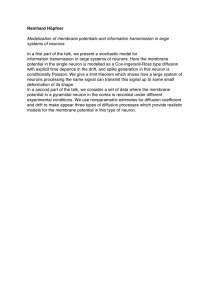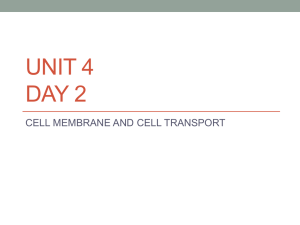Neural Tissue Parts list

Neural Tissue
Parts list
Overview: Nervous system functions
1. Sensory input (info travels “in” along
afferent pathways)
– Sensory neurons
2. Integration (information is processed)
– Spinal cord and brain
3. Motor output (info results in a response, travels along efferent pathways)
– Stimulation of skeletal muscle, smooth muscle, cardiac muscle, & glands
Sensory-Motor Pathways
Overview
Neural tissue: specialized cells
• Neurons
• Supporting cells (non-excitable cells) or neuroglia; outnumber neurons 10 to
1
• Blood vessels
• Connective tissue
Neurons
• Specialized cells that communicate with other cells via changes in the membrane potential and synaptic connections
• Characteristics:
– Extremely long-lived (> 100yrs)
– Amitotic
– Extremely high metabolic rate
Typical Neuron
Neurons have special names for cell structures
• Cell body: contains the nucleus
• Perikaryon: cytoplasm around the nucleus
• Nissl bodies are localized RER and ribosomes
Typical motor neuron
Synapse of a motor neuron
Classified by structure
Classified by function
(sensory or motor)
Neuroglia are supporting cells
Neuroglia are supporting cells
Wandering police force
CNS
Regulating/recycling/maintaining myelinate axons
Circulate CSF
PNS
Ependymal cells make and help circulate CSF
Schwann cells in PNS
Nerve regeneration is assisted by Schwann cells
Neurophysiology
Overview
Neurons are excitable cells
• Have we talked about a model in another cell for propagation of an impulse?
• How does the chemical composition of the cell membrane promote a separation of ions?
• Which ions are in greater concentration
inside the cell? Outside the cell?
Electrochemical gradient
• A charge difference exists, like between poles of a battery.
• Intracellular : high concentration of K + ions & negatively charged proteins
• Extracellular: high concentration of Na + & Cl ions
Two gradients =
• The sum of the chemical and electrical forces acting across the membrane =
Electrochemical gradient (AKA membrane potential)
• Size of the potential difference is measured in milliVolts (mV)
• Neurons have a resting transmembrane potential of approx. -70mV
Resting Membrane Potential
Electrochemical gradient
Ion diffusion in neurons
• Ions are always diffusing, BUT can cross membrane quickly ONLY through channels
• Types of channels
– Passive or leak channels (ungated; always open)
– Active or gated channels (always closed, unless…)
Gated Channels
• Chemically regulated: Respond to presence of particular chemicals
• Voltage regulated: respond to changes in membrane potential
• Mechanically regulated: respond to physical deformation
Have we seen examples of these channels in other tissue?
chemical
Gated Channels electrical mechanical
If gated channels open…
• What happens to the transmembrane potential?
Graded Potential
• A change in the transmembrane potential that does not travel far from the area of stimulation
• Definitions
– Depolarization: shift towards 0mV
– Repolarization: shift towards the resting membrane potential (~-60mV)
– Hyperpolarization: membrane becomes more negative
Graded Potential
Graded Potential
Graded Potential
Action Potential
• Propagated changes in the transmembrane potential that affect an
entire excitable membrane and results in release of a neurotransmitter
• ALL OR NOTHING response.
Action Potential
Action Potential
AP Propagation







